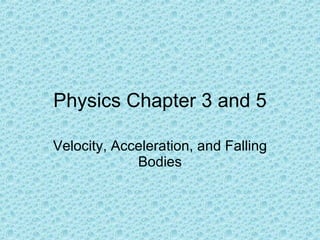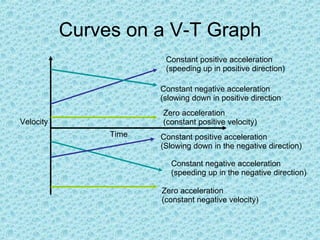Physics Chapter 3 And 5
- 1. Physics Chapter 3 and 5 Velocity, Acceleration, and Falling Bodies
- 2. Reference Point – the point that all objects are measured from What is similar about these two clips? What is different about these two clips? They are similar because they both traveled the same distance (10 yards) The are different because one traveled forward and the other traveled backwards.
- 3. Scalars vs. Vectors The distance is the separation between objects. It does not have a direction and is called a scalar The position or displacement is the separation between the object and the reference point. It does have a direction and is called a vector
- 4. Displacement Displacement – change in position; What is the displacement of the runner in the clip? 0 yards What is the distance traveled? 20 yards
- 5. Speed and Velocity Speed is simply saying that Ed here is going 80 mph. Speed is a scalar. Velocity is saying that Ed is going 80 mph in a easterly direction. Velocity is a vector.
- 6. Velocity Average Velocity – the total displacement over the time interval v = d f – d i / t f – t i Constant velocity – the average velocity is the same for all time intervals – Zero acceleration
- 7. Question Is a merry go round experiencing constant speed or constant velocity? The answer is … Constant speed because its direction is constantly changing.
- 8. Position-Time Graphs Instantaneous position – the location of an object at a single instant The slope on a position-time graph gives you constant velocity
- 9. Curves on a P-T Graph Constant positive velocity (going forward) Constant negative velocity (going backward) Zero Velocity (not moving) Accelerating P o s i t i o n Time
- 10. Position-Time Graph 15 10 5 Meters (m) 2 4 6 8 10 12 14 Time (s)
- 11. Find the: Displacement after 4 seconds Displacement after 14 seconds Distance traveled after 14 seconds Velocity from 0-4 sec Velocity from 4-10 sec Velocity from 10-14 sec Acceleration from 0-4 sec 10 m 0 m 20 m 2.5 m/s 0 m/s -2.5 m/s 0 m/s 2
- 12. Velocity-Time Graphs Instantaneous velocity – velocity of an object at a single instant Ex: Your speedometer V-T graphs: the slope of these graphs gives you acceleration Also, the area under the curve of a velocity-time graph gives you the displacement
- 13. Acceleration Acceleration is the change in velocity. A = V f – V i / t
- 14. Curves on a V-T Graph Constant positive acceleration (speeding up in positive direction) Constant negative acceleration (slowing down in positive direction Zero acceleration (constant positive velocity) Constant positive acceleration (Slowing down in the negative direction) Constant negative acceleration (speeding up in the negative direction) Zero acceleration (constant negative velocity) Velocity Time
- 15. 15 10 5 Velocity (m/s) 1 2 3 4 5 6 7 Time (s) 8 9 Velocity-Time Graph
- 16. Find the: Velocity after 2 sec Velocity after 9 sec Acceleration from 0-2 s Acceleration from 2-4s Acceleration from 4-6 s Acceleration form 6-9s Displacement from 0-2 s Displacement from 0-9 s 10 m/s 0 m/s 5 m/s 2 0 m/s 2 2.5 m/s 2 -5 m/s 2 10 m 77.5 m
- 17. Relative Velocity Always remember that motion is relative. The earth is usually our reference point to determine our speed. We are all traveling the same speed relative to the sun.
- 18. Relative Velocity 45 MPH 60 MPH What is the velocity of the blue car relative to the green car? 15 mph What is the velocity of the green car relative to the blue car? -15 mph
- 19. Relative Velocity 55 MPH 40 MPH What is the velocity of the blue car relative to the red car as they head towards one another? 95 mph What is the velocity of the blue car relative to the red car as they head away from one another? -95 mph
- 20. Motion Equations v= v 0 +at d= 0.5(v+v 0 )t d = V 0 t + 0.5at 2 v 2 = v 0 2 + 2ad V = final velocity V 0 = initial velocity d= displacement a= acceleration t = time
- 21. Freefall a= g = -9.8m/s 2 If something is dropped v 0 = 0 At its highest point, an object’s velocity is 0 If an object is falling its displacement is negative.




















